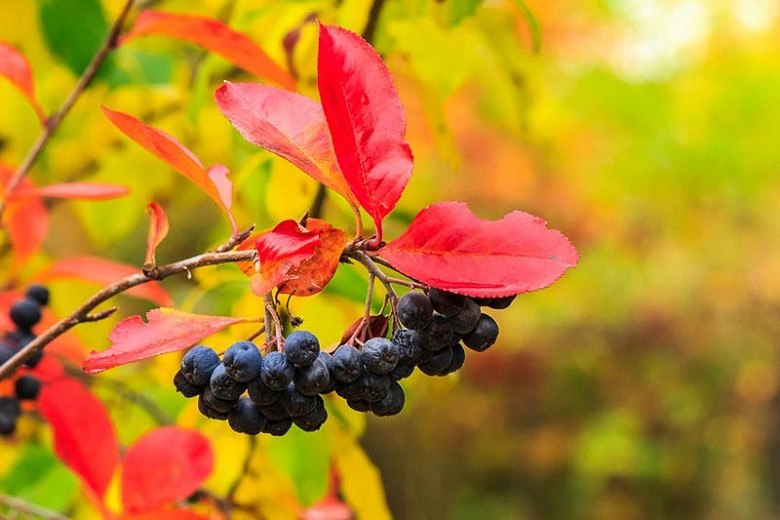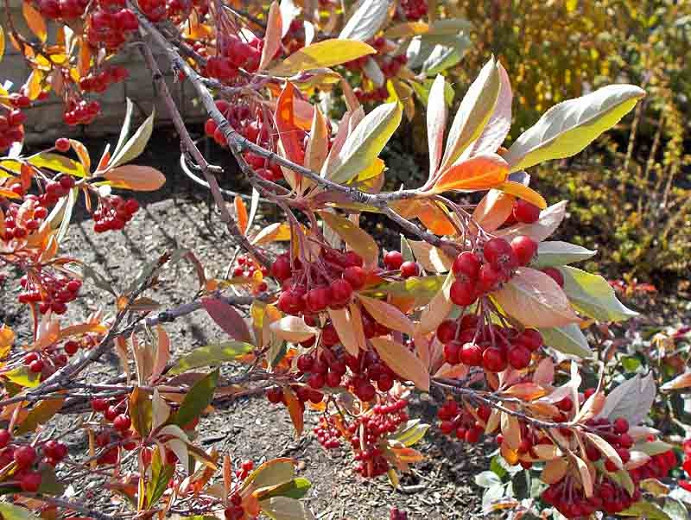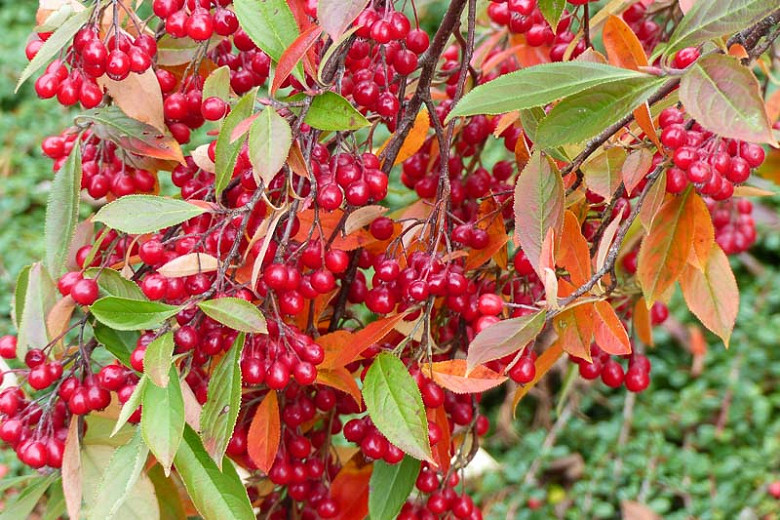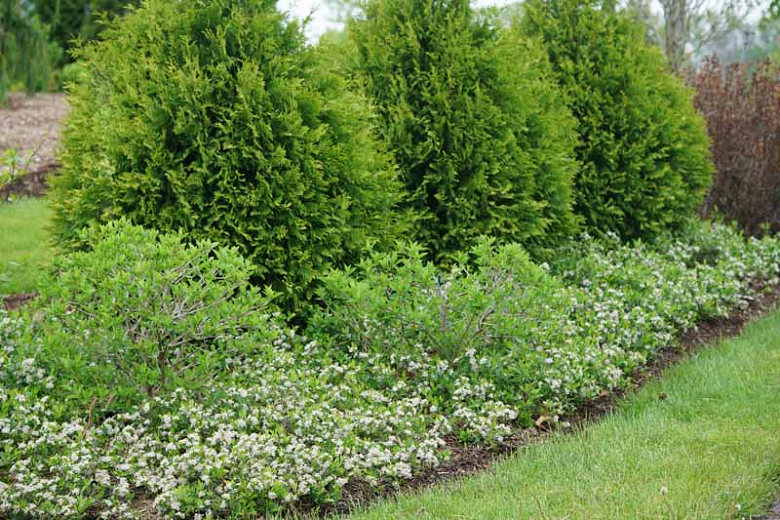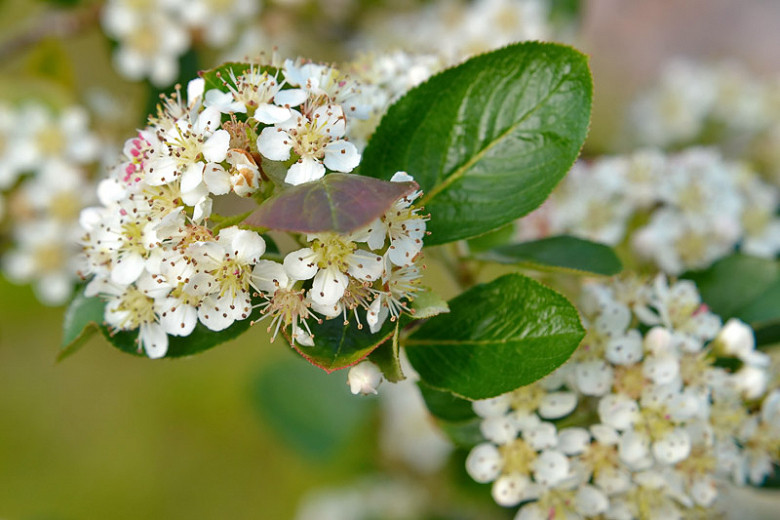Aronia melanocarpa (Black Chokeberry)
Noted for its showy black berries and excellent purple-red foliage color, Aronia melanocarpa (Black Chokeberry) is a very adaptable, spreading, deciduous shrub that adds multi-season beauty to the garden. In spring, a profusion of fragrant, whitish-pink flowers are borne in loose clusters, 2 in wide (5 cm), of up to 8. Rich in nectar, they are of great interest to early butterflies, hummingbirds, and pollinators. The flowers are followed in late summer by abundant, glossy, pendulous clusters of black berries that persist throughout fall and well into winter. Songbirds and upland gamebirds do enjoy them in winter months, as do many species of small mammals. Ornamental and adding winter interest to the landscape, they also make tasty jams and jellies. The foliage of elliptic, finely toothed, lustrous leaves, emerges bright green in spring and darkens as the season progresses before turning brilliant crimson to wine-red to apricot in the fall. Nearly luminescent, the fall foliage brightens darker areas on cloudy fall days. A plant for almost all seasons, which is favored among gardeners for its pollution, drought, insect, and disease tolerance.
- Grows up to 3-6 ft. tall and equal spread (90-180 cm) with a bushy, spreading, suckering habit. Remove root suckers to prevent colonial spread
- A full sun to part shade lover, this plant is easily grown in average, medium moisture, well-drained soils. Best fruit production generally occurs in full sun. May become more leggy in partial shade. Tolerates a wide range of soils, including boggy and wet soils, and dry sandy soils. Drought, salt, and pollution tolerant
- Winner of the GreatPlants award, which is a joint effort between the Nebraska Nursery, Landscape Association, and the Nebraska Statewide Arboretum. The goal of this award is to identify superior ornamental landscape plants that meet the challenging growing conditions of the region.
- Generally pest and disease free, but watch for occasional leaf spot and blight.
- Attracts birds, but is deer resistant.
- Mass in mixed shrub borders, open woodland gardens, and naturalized areas where its suckering, colonial growth habit does not need to be restrained. Perfect for small gardens, rain gardens, or near ponds and streams. May also be used as a backdrop for low-growing perennials or groundcovers in more formal, tight spaces.
- Native from Newfoundland to southern Ontario and Minnesota south to Missouri, Tennessee and Georgia.
Requirements
| Hardiness | 3 – 8 |
|---|---|
| Heat Zones | 3 – 8 |
| Climate Zones | 1A, 1B, 2A, 2B, 3A, 3B, 4, 5, 6, 7, 17, A1, A2 |
| Plant Type | Shrubs |
| Plant Family | Aronia – Chokeberries |
| Exposure | Full Sun, Partial Sun |
| Season of Interest | Spring (Mid,Late)Summer (Early,Mid,Late)FallWinter |
| Height | 3' – 6' (90cm – 180cm) |
| Spread | 3' – 6' (90cm – 180cm) |
| Spacing | 36″ – 72″ (90cm – 180cm) |
| Water Needs | Average |
| Maintenance | Low |
| Soil Type | Chalk, Clay, Loam, Sand |
| Soil pH | Acid, Alkaline, Neutral |
| Soil Drainage | Well-Drained |
| Characteristics | Fragrant, Plant of Merit, Showy, Fruit & Berries |
| Native Plants | United States, Midwest, Illinois, Indiana, Iowa, Michigan, Minnesota, Missouri, Ohio, Wisconsin, Northeast, Connecticut, Delaware, Maine, Massachusetts, Maryland, New Hampshire, New Jersey, New York, Pennsylvania, Rhode Island, Vermont, Southeast, Alabama, Arkansas, Georgia, Kentucky, Mississippi, North Carolina, South Carolina, Tennessee, Virginia, West Virginia |
| Tolerance | Deer, Drought, Dry Soil, Salt, Wet Soil |
| Attracts | Birds, Butterflies, Hummingbirds |
| Garden Uses | Beds and Borders, Hedges and Screens, Ponds and Streams, Rain Gardens, Small Gardens |
| Garden Styles | City and Courtyard, Informal and Cottage, Prairie and Meadow, Traditional Garden |
